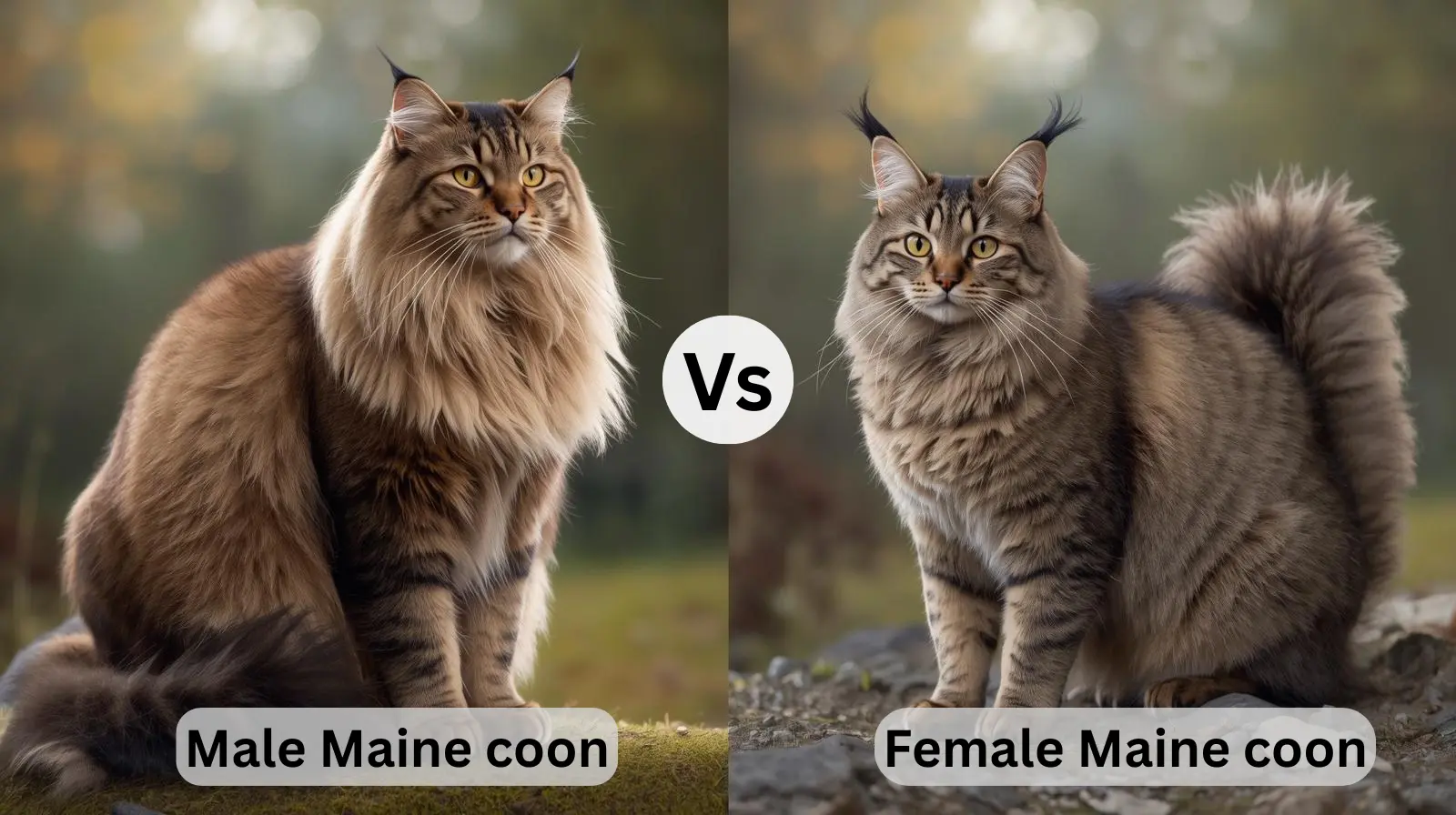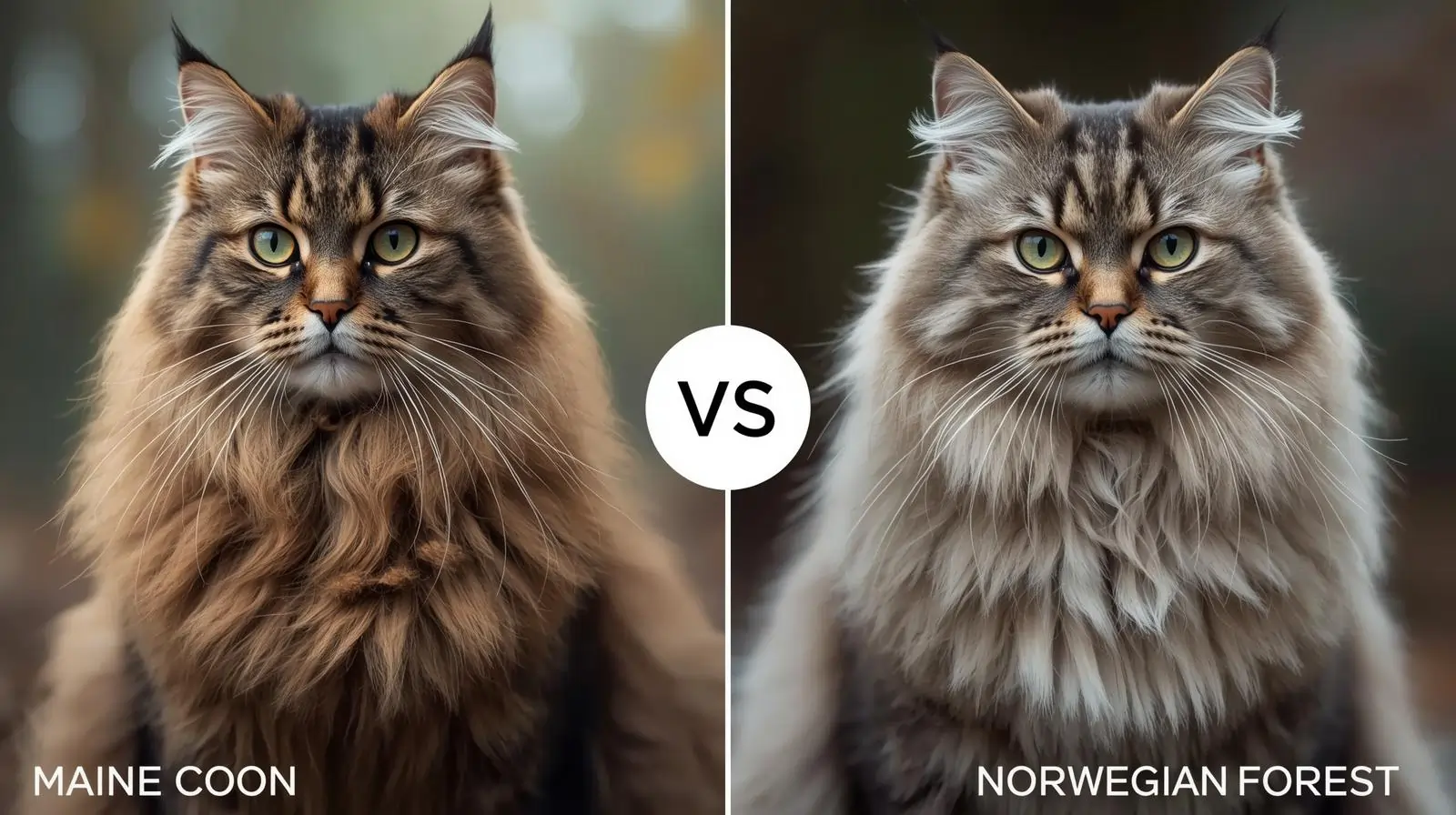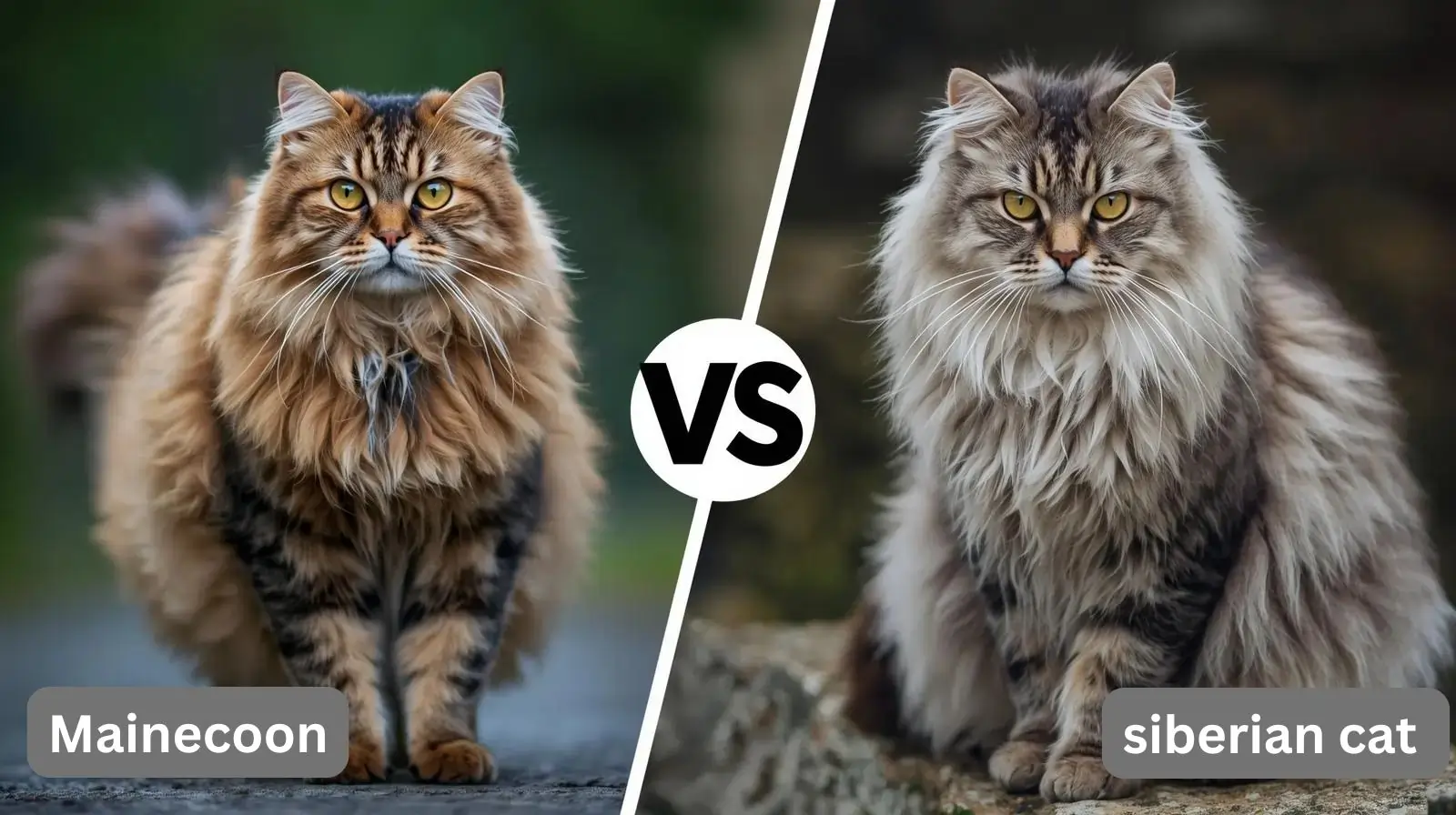Bobcat vs Mountain Lion: The Ultimate Wildlife Comparison
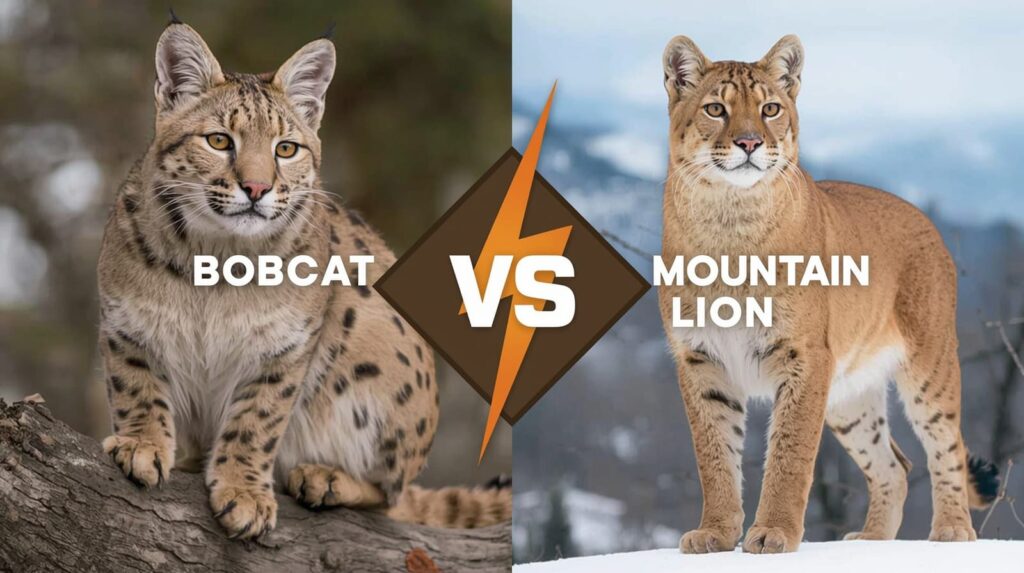
The wilderness echoes with mysteries, and none are more fascinating than the bobcat vs mountain lion debate. Last autumn, while hiking through Colorado’s Rocky Mountain trails, I spotted what I initially thought was a large domestic cat perched on a boulder. My heart raced as I reached for my camera, only to realize this “house cat” was actually a bobcat North America’s most common wild feline. That encounter sparked my deep dive into understanding these magnificent predators and their larger, more elusive cousin: the mountain lion.
Understanding North America’s Wild Cats
When discussing the bobcat vs mountain lion comparison, we’re examining two apex predators that share territories but couldn’t be more different in appearance, behavior, and ecological impact. These cats represent fascinating examples of evolutionary adaptation, with each species carving out its unique niche in the American wilderness.
The United States is home to an estimated 2.4 to 3.6 million bobcats, making them remarkably successful despite human encroachment. Meanwhile, mountain lion populations in the U.S. range between 20,000 and 40,000 individuals, with conservation groups suggesting the actual number hovers around 30,000. Understanding bobcat and mountain lion population dynamics helps wildlife managers develop effective conservation strategies.
Physical Differences: Size Matters in Bobcat vs Mountain Lion
Body Structure and Weight
The most striking difference in the bobcat vs mountain lion comparison lies in their physical dimensions. Bobcats typically weigh between 15 and 35 pounds, roughly twice the size of a domestic cat. In contrast, female mountain lions can weigh up to 140 pounds, while males can reach up to 220 pounds.
This size disparity translates to dramatically different hunting capabilities and territorial requirements. A bobcat’s compact build allows it to navigate dense underbrush and suburban environments with ease, while the mountain lion’s muscular frame enables it to take down prey five times its size. When comparing bobcat and mountain lion physical characteristics, the weight difference alone tells a compelling story.
Distinctive Physical Features
| Feature | Bobcat | Mountain Lion |
|---|---|---|
| Weight | 15–35 lbs (7–16 kg) | 90–220 lbs (40–100 kg) |
| Body Length | Up to 50 inches | Up to 8 feet |
| Tail | Short, “bobbed” (3.5–4.3 inches) | Long, slender (up to 3 feet) |
| Coat Pattern | Spotted with gray to brown base | Uniform tan/tawny, no spots |
| Ear Tufts | Prominent black tufts | Rounded, no tufts |
| Height at Shoulder | 18–24 inches | 24–35 inches |
Bobcats have a distinctive spotted coat with a base color ranging from gray to brown, while mountain lions display a uniform tan or tawny coat without spots. This distinction is crucial for wildlife identification and understanding their respective camouflage strategies in the bobcat vs mountain lion visual comparison.
Population Statistics: Current Wildlife Trends
Bobcat Population Growth
Recent wildlife surveys reveal encouraging trends for bobcat populations across North America. Population estimates indicate between 2,352,276 to 3,571,681 bobcats exist throughout the entire United States, with populations reported as stable or increasing in 40 states.
California hosts the largest bobcat population with approximately 30,000 to 50,000 individuals living in all 58 counties. This remarkable distribution demonstrates the bobcat’s exceptional adaptability to various ecosystems, from desert landscapes to suburban neighborhoods.
Mountain Lion Conservation Status
The bobcat vs mountain lion population comparison reveals a stark contrast. Colorado’s projected statewide population of independent mountain lions (not including kittens) ranges around 3,800 to 4,400 individuals. Annual statewide mountain lion harvest has averaged 505 lions in the most recent three years.
State-by-state mountain lion populations show significant variation:
- Oregon: 6,000+ (stable and sustainable)
- New Mexico: 3,500 (thriving in rugged terrain)
- Montana: 3,000-5,000 (controlled hunting practices)
- Idaho: Approximately 2,000
- Nevada: 2,000 (essential for ecosystem balance)
Habitat Preferences: Where Bobcat vs Mountain Lion Diverge
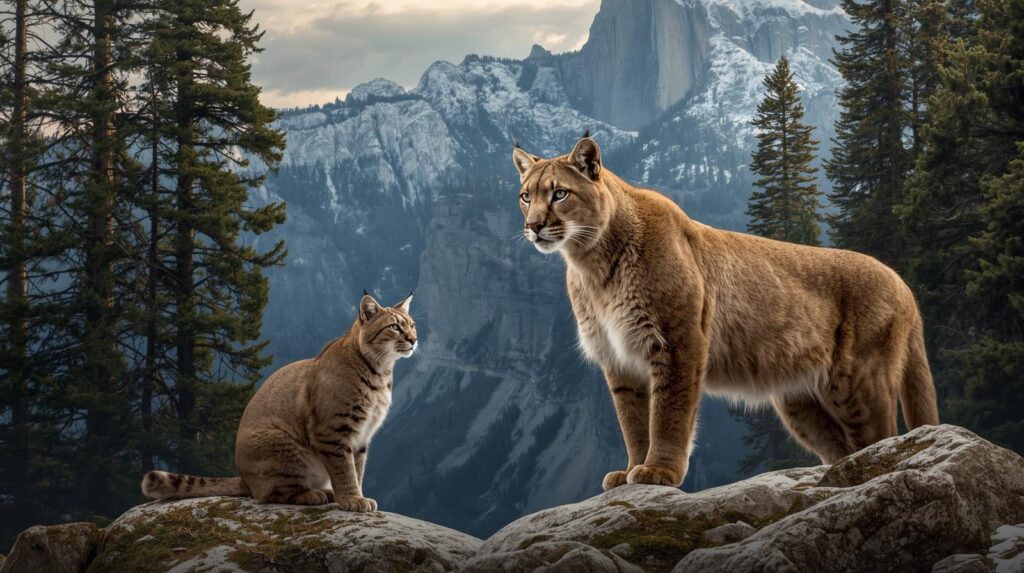
Bobcat Adaptability
One fascinating aspect of the bobcat vs mountain lion discussion involves their habitat preferences. Bobcats are shy, secretive, and solitary creatures that are primarily crepuscular, meaning they’re active only during dawn and dusk. Their remarkable adaptability allows them to thrive in environments where mountain lions cannot survive.
Bobcats demonstrate resilience to human disturbance, including urbanization, land development, road construction, and deforestation. They’ve been documented in suburban backyards, city parks, and even golf courses anywhere with sufficient prey and minimal direct human interference. The habitat flexibility of bobcat and mountain lion species differs dramatically based on their territorial needs.
Mountain Lion Territory Requirements
Mountain lions are much bigger than bobcats, ranging from 7-8 feet long and weighing up to 140 pounds, requiring large territories that make urban living impossible. Their prey requirements primarily deer and elk necessitate expansive, undeveloped wilderness areas.
Through my research and conversations with wildlife biologists for this Maine coon Guides resource, I’ve learned that mountain lions require approximately 150 square miles of territory for males, while females occupy about 50 square miles. This massive spatial requirement explains why mountain lion populations remain concentrated in western states with vast wilderness areas, making the bobcat vs mountain lion habitat comparison particularly interesting.
Behavioral Patterns: Hunting and Social Structure
Hunting Strategies in Bobcat vs Mountain Lion
Both species are ambush predators, relying on stealth and surprise. However, their prey preferences dramatically differ based on size capabilities in the bobcat vs mountain lion hunting comparison.
Bobcats primarily hunt rabbits, squirrels, and occasionally goats in rare cases. Their smaller size limits them to prey weighing less than 20 pounds, though they’ve been known to take down young deer opportunistically.
Mountain lions tackle deer, coyotes, and larger animals as apex predators. Each adult mountain lion consumes approximately 50 mule deer per year, playing a crucial role in regulating ungulate populations and maintaining ecosystem health. When examining bobcat and mountain lion dietary habits, the size difference between prey species is remarkable.
Territorial Behavior
The bobcat vs mountain lion comparison extends to their social structures. Both cats are predominantly solitary, coming together only for mating. However, their territorial behaviors differ significantly.
Bobcats maintain relatively small home ranges, typically 1-18 square miles depending on prey availability and habitat quality. They mark territories with scent markings and rarely engage in lethal conflicts with other bobcats.
Mountain lions exhibit more aggressive territorial behavior, particularly males who will fight to the death to defend their domains. This territoriality serves an important ecological function, naturally regulating population density and preventing overexploitation of prey resources.
Human Interactions: Safety and Coexistence
Bobcat Encounters
Bobcats are not known to attack humans and neither species wants anything to do with people. Their natural fear of humans makes encounters brief and typically harmless. However, they may prey upon small pets, particularly outdoor cats and small dogs, making supervision essential in bobcat habitats.
During my wildlife photography expeditions, I’ve observed bobcats display remarkable tolerance for human presence at a distance. They’ll often freeze, assess the situation, and quietly disappear into cover a behavior that reflects their adaptive survival strategy in the bobcat vs mountain lion danger assessment.
Mountain Lion Safety
Fatal mountain lion attacks have averaged one every seven years since 1980, demonstrating these encounters remain extremely rare despite growing human populations in mountain lion territory. To put this in perspective, lightning and domestic dogs pose significantly greater threats to human safety.
Mountain lions are fearful and reclusive, generally avoiding human contact. When encounters do occur, wildlife officials recommend standing tall, maintaining eye contact, speaking firmly, and backing away slowly never running, which can trigger predatory instincts. Understanding bobcat and mountain lion behavior patterns is essential for safe wilderness recreation.
Ecological Importance: Roles in the Ecosystem
Apex and Meso-Predator Functions
The bobcat vs mountain lion ecological comparison reveals complementary roles within North American ecosystems. Mountain lions are apex predators at the top of the food chain without natural predators, playing a crucial role in maintaining ecosystem health and balance by controlling prey populations.
Bobcats are considered meso-predators, medium-sized carnivores occupying a mid-ranking position in the trophic system. They control rodent populations, rabbits, and other small mammals, preventing overgrazing and vegetation damage.
Conservation and Management Challenges
Colorado Parks and Wildlife believes managing lions and bobcats with harvest is a tool to maintain more stable populations compared to widely fluctuating populations that would likely occur without regulated hunting.
Statewide annual harvest proportion of female mountain lions in Colorado is generally at or under 40%, whereas in states that banned hound hunting, it approaches 60%. This data suggests selective hunting practices can maintain healthier sex ratios in mountain lion populations, which is critical in the bobcat vs mountain lion management strategy discussion.
Regional Distribution Patterns
Geographic Range Comparison
The bobcat vs mountain lion geographic distribution reveals the bobcat’s superior adaptability. Bobcats are found in each contiguous U.S. state except Delaware, representing one of the most successful carnivore distributions in North America.
Mountain lions, while historically present across the continent, now primarily inhabit 15 western states plus Florida. The eastern cougar subspecies was declared officially extinct by the U.S. Fish & Wildlife Service in 2011, though individual mountain lions from western populations occasionally wander eastward, suggesting potential future recolonization.
Climate and Habitat Adaptations
Bobcats demonstrate remarkable versatility in the bobcat vs mountain lion climate adaptation comparison. They thrive in environments ranging from scorching deserts to snowy mountains, coastal swamps to prairie grasslands. This adaptability stems from their flexible diet and modest territory requirements.
Mountain lions show similar habitat versatility but require larger contiguous wilderness areas. They’re found from Canada’s Yukon Territory to the southern Andes in Chile, representing the most extensive range of any wild land mammal in the Americas. The adaptability of bobcat and mountain lion populations to diverse climates showcases their evolutionary success.
Management and Hunting Regulations
State-Level Harvest Data
Wildlife management agencies carefully monitor both species through regulated hunting and trapping seasons. From 2020-2023, mountain lion damage payments averaged $50,000 annually for documented livestock losses.
Annual bobcat harvest from 2020-2023 averaged 880 animals in Colorado, while the minimum U.S. range-wide population estimate remains robust at 1.4 to 2.6 million bobcats. These figures inform the ongoing bobcat vs mountain lion conservation planning efforts.
Conservation Success Stories
The bobcat vs mountain lion conservation narrative showcases different trajectories. Populations were reported stable or increasing in 40 states, with only Florida reporting decreases in bobcat populations. This success story reflects effective wildlife management and the species’ inherent adaptability.
Mountain lion populations have stabilized in many western states following earlier decimation, though they face ongoing challenges from habitat fragmentation, human development, and climate change impacts on prey availability.
Future Outlook: Coexisting with Wild Cats
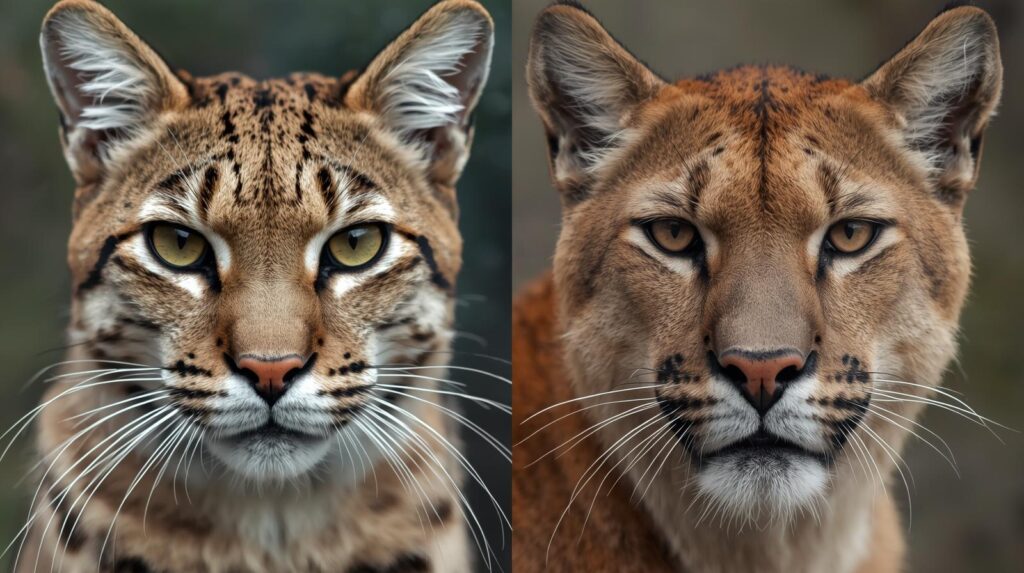
As human populations continue expanding into wildlife habitats, understanding the bobcat vs mountain lion differences becomes increasingly important for conservation and public safety. Both species serve vital ecological functions, and their continued survival depends on maintaining habitat corridors, minimizing human-wildlife conflicts, and supporting science-based management practices.
The next decade will likely see increased bobcat sightings in suburban areas as populations continue growing, while mountain lions may attempt recolonization of historical eastern territories if suitable habitat and prey populations persist. Wildlife officials, conservation organizations, and local communities must collaborate to ensure these magnificent predators thrive for future generations.
Frequently Asked Questions
Q: Can a bobcat kill a mountain lion?
No, bobcats cannot kill mountain lions. The size disparity is too significant mountain lions weigh 6-7 times more than bobcats and possess far superior strength. Bobcats actively avoid mountain lion territories to prevent potentially fatal encounters.
Q: Which is more dangerous to humans: bobcat or mountain lion?
Mountain lions pose greater potential danger due to their size and strength, though both species typically avoid human contact. Fatal bobcat attacks on humans are virtually nonexistent, while mountain lion attacks, though extremely rare, can be serious.
Q: Do bobcats and mountain lions live in the same areas?
Yes, their ranges overlap throughout much of the western United States. However, they occupy different ecological niches and generally avoid direct interaction. Bobcats may adjust their activity patterns in areas with high mountain lion density.
Q: How can I tell if I’m looking at a bobcat or mountain lion?
The tail is the easiest identifier bobcats have short, “bobbed” tails (3-4 inches), while mountain lions have long tails (up to 3 feet). Size is another clear indicator, with mountain lions being significantly larger and lacking the spotted coat pattern of bobcats.
Q: Are bobcat and mountain lion populations increasing or decreasing?
Bobcat populations are stable or increasing in 40 U.S. states, demonstrating remarkable resilience. Mountain lion populations have stabilized in western states after historical declines, though they face ongoing conservation challenges. Are these trends sustainable given continued human development and climate change pressures?


